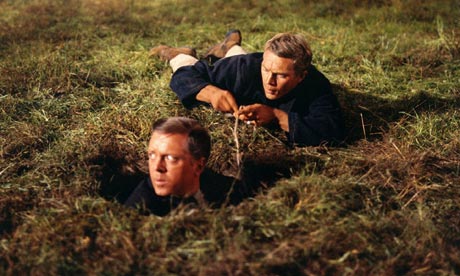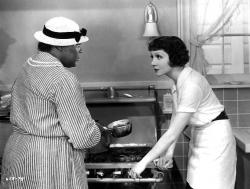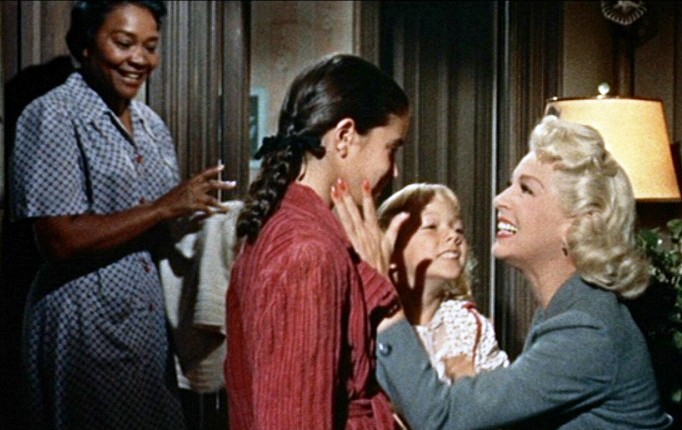Originally a Southern event designated to honor
Confederate veterans of the Civil War, Memorial Day went on to become a
nationally recognized holiday in the United States, which now honors all
American veterans. While today the true meaning of the holiday is too often lost
amidst the barbeques, beach days, and block parties that it has since become
associated with, it remains at its heart a commemoration of the bravery and
sacrifice of our men and women in uniform. Below are three films that celebrate
and honor America’s men and women in arms and all that they stand for.
 |
| Kiss this man's feet! |
PATTON: Part biography and part war epic, 1970’s Patton remains an invigorating mix of
the best of both genres. The film covers the years that General George S.
Patton (George C Scott) spent as one of the nation’s most skilled and controversial
military leaders in WWII. Throughout the film, Scott captures Patton’s brilliance
and insatiable drive with equal skill, and brings the colorful and complex general
to life. While lauded as one of the nation’s most successful military leaders, Patton’s
career was fraught with controversy as he alienated allied leaders whom he
regarded as professional rivals, and continually disobeyed Washington’s orders.
The film successfully makes him a by turns frustrating and inspiring, but
always fascinating character and does full justice to his complicated life and
career. The film portrays the war with the same nuance that it affords its
protagonist by highlighting both the animosity that existed between the allies and
the political machinations that divided the war effort. The supporting cast
turns in uniformly excellent performances with particularly notable turns from
Karl Malden as Patton’s beleaguered right-hand man, Major General Omar Bradley,
and Michael Bates as his greatest rival, smug British general Bernard
Montgomery. The film’s opening sequence featuring Patton delivering a
passionate speech to his troops in front of a massive American flag remains nothing
short of iconic, even today, and its message of resilience continues to resonate.
While the film closes with the observation that ‘all glory is fleeting’ Patton remains an example of cinema at
its most glorious.
 |
| Houdini's got nothing on these guys |
THE GREAT ESCAPE: Based upon another true story from
WWII, 1963’s The Great Escape chronicles
the mass escape from German prison camp Stalag Luft III in 1943. The film
begins with the SS moving its most skilled and determined prisoners of war to a
high security prison in hopes of preventing their escape. What the SS fails to
account for is the fact that by placing so many ‘escape artists’ in one
facility they have in fact made continued, and even more sophisticated, escape
plans inevitable. The film then follows the diverse group of allied prisoners
as they overcome their many differences and forge a plan for the ultimate
escape. While the plot of the film follows a familiar pattern, the fact-based
fate of the famed fifty escapees remains tragically poignant. Similarly the
prisoners’ efforts to obtain freedom not only for themselves, but also for each
of their comrades, remain an inspiring testament to the power of teamwork and camaraderie
in the face even the greatest of adversity. The film’s ensemble cast
brilliantly brings the story of the fifty to life with standout performances
from Steve McQueen as American loner Capt. Virgil Hilts, whose repeated stays
in solitary confinement earn him the nickname ‘cooler king’ and Richard
Attenborough as RAF squadron leader Roger Bartlett, whose leadership earns him
the codename ‘big x’. The film’s chase scene featuring McQueen attempting to
elude the SS on a motorcycle and its signature tune continue to be imitated and
parodied, but have yet to be equaled. For a truly great war film, look no further
than The Great Escape.
 |
| And you thought he was strictly a comic actor |
BEHIND ENEMY LINES: This action-packed true-story explores
the United States’ involvement in the Bosnian War of the 1990’s, a conflict
that is largely ignored by Hollywood. The film begins with US naval Lieutenant
Chris Burnett (Owen Wilson) contemplating returning to civilian life after
becoming disillusioned with the military and the political bureaucracy that has
ordered the military to remain largely neutral in Bosnia. Later, however,
Burnett is given the chance to take matters into his own hands when he captures
evidence of the atrocities that are being committed by the Bosnian-Serb army.
Before he can turn the crucial evidence over to his superiors, however, his
plane is shot down and crash lands in Bosnia. He then witnesses the execution
of his co-pilot at the hands of the Bosnian-Serb army and is forced on the run
after narrowly escaping with his life. The film then chronicles his journey of
survival through enemy territory as he struggles to return home and expose the
genocide that he has discovered. While the film takes liberties with the facts
of the Mkronjic Grad Incident, which its plot is based upon, it does succeed in
bringing attention to a conflict that is often misunderstood. The film also
succeeds in providing insight into the ways that political and military agendas
can contradict and come into conflict with one another even as both struggle to
reach a solution that is best for the country. For an action-packed look at
modern warfare, take a journey Behind
Enemy Lines.



